The Puffballs
21st October 2015Identifying Edible Puffballs
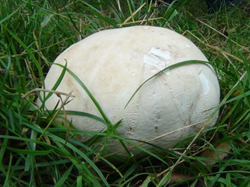
Giant Puffball
Puffballs are a great family of mushrooms for novice foragers to pick from, for a number of reasons…
- All true Puffballs found in the UK are edible when young.
- They grow almost all year round and can often be found in large quantities.
- With a little care they are easy to identify.
- Some of them are very tasty!
The safest of all UK mushrooms to identify, is also the best tasting in the Puffball family; the Giant Puffball, Calvatia gigantia. It has no look-a-likes when mature, and will provide a decent sized meal from just one mushroom.
An average Giant Puffball can produce seven trillion spores. These spores are very fussy and the mushroom is lucky if more than 1 of them grows to 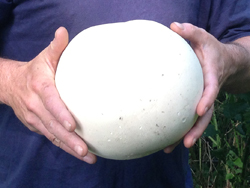 maturity.
maturity.
This is quite lucky for us too, as it has been calculated that if each spore from one mushroom germinated and the same happened to that generation, it would produce a mass of fungi 800 times the volume of the Earth!
In 2010, schoolboy Finley O’Neil from Yorkshire found a world record breaking Giant Puffball, measuring 66.5 inches (nearly 170 cm) in diameter. The Giant Puffball holds another record too; it produces more progeny than any other living thing.
Calvatia gigantia roughly translates to giant bald head!
Not all are as easy to identify as the giants though; other family members range in size from less than a marble, to bigger than a beach ball. There are roughly 18 members of the true Puffball family in the UK.
Identification
To ensure that you have an edible Puffball, follow these simple rules:
First find a mushroom without gills, spines or pores under the non existent cap! Basically, find a mushroom that either looks like a ball or a ball with an elongated stem. Pictured right are young Stump Puffballs.
For further identification purposes, the ball-like mushroom you have found must be cut in half.
Inside, the mushroom should be pure white with a spongy flesh and nothing else. Young fresh edible Puffballs have white spongy flesh all the way through the mushroom. See the Common Puffball sliced through below right.
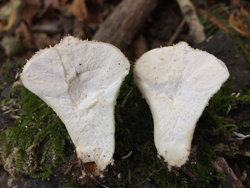
As the mushroom matures, the flesh inside will begin to turn yellow. This is now no longer edible and can make people sick.
There are a few nasty look-a-likes, which is why cutting the mushroom in half is an important key to identifying which Puffball you have found.
If there is anything else apart from white sponge inside your mushroom, it is NOT an edible puffball.
Potential Confusions
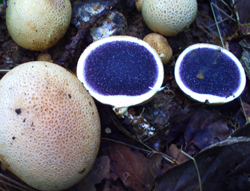
Earthballs
The Earthballs
These mushrooms fool many people and account for the second most mushroom poisonings in the UK each year. They are not deadly, but can make you very ill.
Earthballs are easily identified though, as they have a tough warted skin, giving them their other common name ‘The Poison Pigskin Puffball’.
They are also more solid to the touch and less spongy throughout. If cut in half, almost all Earthballs are purple or black in the middle; this should put most people off eating them!
But beware, as some species of Earthball can remain white in the middle; though they are still much firmer to the touch and without the spongy effect inside. The skin will still be tough and warty.
Remember; if you are at all unsure of what you have found, follow the rule and do not eat it!
The Amanitas
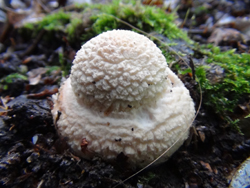 Some members of the Aminita family are Deadly. This family of mushrooms grow from a white ‘egg sack’, which can look very much like a puffball, as shown in the picture on the right.
Some members of the Aminita family are Deadly. This family of mushrooms grow from a white ‘egg sack’, which can look very much like a puffball, as shown in the picture on the right.
If cut in half, this egg sack would reveal a small mushroom ready to burst through the egg skin and start growing.
Do not eat an Amanita Egg! Only some Amanitas are edible and these can only be identified when they are beyond the egg stage.
Some Amanitas, including the Death Cap and the Destroying Angel are deadly poisonous with no known cure.
The Stinkhorn mushroom
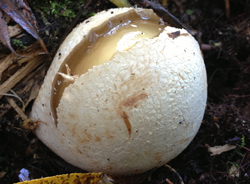
Immature Stinkhorn ‘Egg’
This mushroom also grows from an egg, but it is easily identified by the gelatinous layer between the immature mushroom inside and the skin of the egg.
Some parts of the Stinkhorn are actually edible, if a little smelly! But if you are going to try this, you must to be 100% certain that you do not have an Amanita instead!
If you slice a Stinkhorn through, it will be pretty obvious that it isn’t a mamber of the Puffball family that you’ve found.
Watch what happened when we did the taste test in our Stinkhorn YouTube video.
Volvariella mushrooms
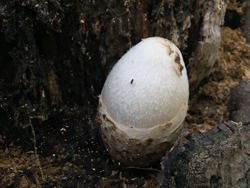
Young Silky Rosegill
These also grow from an egg sack and although they are listed as edible, they are too similar to the Amanitas to be of any interest to a forager.
One of the prettiest of the Volvariella family is the delicate Silky Rosegill (Volvariella bombycina).
We were lucky enough to spot one of these rare fungi, watch our Silky Rosegill YouTube video.
Cooking and preparation
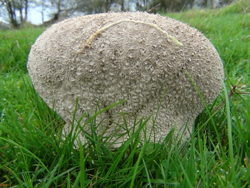
We use the large Mozaic Puffballs (pictured right) and even larger Giant Puffballs to make our Puffball schnitzels. This simple method is the best way we have found of cooking them.
These mushrooms have a lovely flavour, but when fried in large slices they do tend to end up with a rather floppy texture. Coating them with breadcrumbs before frying helps to firm them up a little.
The Smaller Puffballs
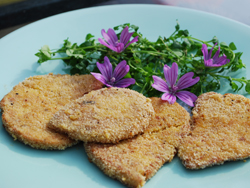 The smaller Puffballs generally have less flavour than the larger ones, but can still be used to create some tasty meals. Their spongy composition enables them to soak up a marinade fairly quickly, so are great for carrying flavour into your meals.
The smaller Puffballs generally have less flavour than the larger ones, but can still be used to create some tasty meals. Their spongy composition enables them to soak up a marinade fairly quickly, so are great for carrying flavour into your meals.
They can be used in the same way as described for the Giant Puffball schnitzels, (pictured on the right) or added to stir-fries and pasta dishes.
A bit more about Puffballs..
Puffballs are a ‘Decay Fungus’ and play a massively important role in the care of our environment. Along with the likes of Oyster Mushrooms and Honey Fungus, they are one of the few living organisms that are able to breakdown and encourage decomposition of the toughest material in wood; Lignin. Without them, our planet would be covered in fallen trees and organic matter to such a depth, it would be extremely slow and difficult to continually break it all down.
If inhaled in large quantities, Puffball spores can lead to Lycoperdonitis which causes inflammation of the alveoli in the lungs. This was discovered through an old nosebleed cure; however, I don’t know if contracting Lycoperdonitis can cure nosebleeds…
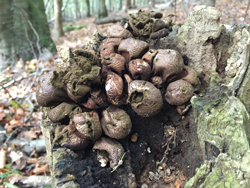
More shockingly, in 1967 eight teenagers from Wisconsin snorted Puffball spores whilst searching for a ‘high’, but ended up hospitalised for four weeks! It is reported that the spores germinated to hyphae stage in the lungs and had to be treated with a fungicide.
There have been no human fatalities associated with Puffballs, but dogs breathing in large amounts of the spores have died.
The spores have many sharp microscopic spines which can cause severe irritation of the lungs. It can be equally as bad if you get the spores in your eyes.
It’s not all bad news with the spores though, smithies used to keep Puffballs in the forge to help heal burns and as a styptic to stop bleeding. As it turns out they knew what they were doing; these spores are antibacterial, antifungal and antimicrobial, fighting Bacillus subtilis, Staphylococcus aureus, Salmonella typhimurium and Escherichia coli (the list goes on) as effectively as the antibiotic Ampicillin!
The fungus starts white throughout but when mature the interior turns yellow to purple to brown and becomes many millions of spores called a gleba with a paper thin skin holding them together. The mushrooms are then light enough to be blown around, therefore spreading the spores.
Even one raindrop hitting the mushroom can cause the spores to shoot out of the fungi at a velocity of about 100 cm/second. This forms a centimetre tall cloud one-hundredth of a second after impact. A single puff like this can release over a million spores in the Common Puffball, the spores being typically 3.5 to 4 microns in size.
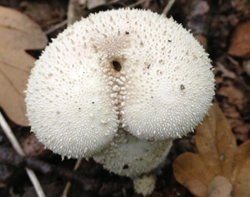
The scientific name for most of the Puffball family is Lycoperdon, which translates as Wolf Farts, with Lyco meaning wolf and perdon, burst of wind…
Puffballs are placed within the Basidiomycota group of fungus, meaning the spores are on the inside. Its old name Gastromycete, means ‘stomach fungi’.
Oh, and sometimes they can grow in some amusing shapes!…


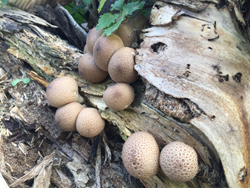
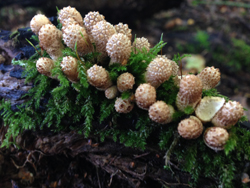



35 comments for The Puffballs
Dear Eric and Marlow,
What a very helpful article – thank you for putting this out there, and the video is delightful (on the puffball Fairy ring).
Considering the rarity of puff balls together (although you point out their occurrence is clearly growing) I noticed 2 chunks of chalk sitting together underneath an old but healthy large lavender bush. Only they seemed to be getting larger as the days went by! They are of course puff balls trying to push against the lower branches of a dense lavender. My soil is sandy in a suburban garden in Godalming, Surrey.
I now look forward to eating them!
Many thanks,
Jane
Agreed. Very helpful.
Great webpage – thanks! I found a massive puff ball one night in our lane but had to go away for work early next morning for a few days. I’ve just cut it open and sadly whilst most of it is still spongy white flesh, a quarter has started to turn yellow. Am so disappointed! It’s been years since I last found and devoured one with huge pleasure!
Thank you for a very informative and comprehensive review, as well as being entertaining. The comments on the capacity to degrade lignin and the fortunate (for us) inefficiency of spore reproduction and the antibiotic properties of the spores were particularly fascinating.
Here in Finland the most common species is L. perlatum and today I found some largish specimens unusually fresh. So reading about their English relatives and edibility was much appreciated.
I agree whole heartedly with the other comments. I found a beauty yesterday, shared half with a friend, and was about to make a stroganoff when I was advised not to. I am now massively reassured and look forward to sometning scrumptious this evening – possibly schnitzels 😋
i have found several pale yellow puffballs, White solid inside. Are these edible?
I would need to see them before I could ID them.
Hi I have cooked a Puffball in butter ,oil ,garlic . And put in a jar a bit like Confit how long do think it will last ? Thanks
Unless all the water from the Puffball is removed, water from foods left in oil can cause botulism after a month or two.
If a giant puffball produces around 7 trillion spores, yet hardly any of them are successful, there’s little point in trying to grow them in my garden.
A former employer of mine had some in his garden. They used to carve slices off them, leaving the rest to grow back.
I once had some fried for breakfast. Best mushroom I’ve ever tasted.
Thank you for this informative article – on our first UK forage (I’m Canadian) I was ecstatic to find what I thought could only be young UK puffballs. We brought home three slightly larger than satsumas. When I cut into them two were horribly black within but the third was still white (though you could see a slight delineation where it would have turned.)
Had we been unlucky enough to have collected three with the white colouring, we may have been having a rough weekend!
I will check and cross-check going forward!
Found three today; all about the size of smallish footballs.
The one I harvested can consider its crimes overnight, and then I will eat it tomorrow for breakfast.
I have just found a large puff ball in my front garden, I thought it was a football, when I poked it with my finger the inside was bright yellow like a form of filler, how is it best to dispose of it? I have taken a photo of it.
The best way is to kick it around a grassy area to release some spores and hopefully get some more growing.
I have never been confident enough to foraged wild mushrooms but today I came across what I believe are small puffballs, I would say the averaged a table tennis or golf ball with some a little bigger. I did pick one and opened it from top to bottom and it was pure white and free of any gills or colour. There are a couple of dozen there so am thinking of trying a couple, is there any recommendations on how to cook them please and are there anything I need to know to avoid an upset tummy.
Smaller Puffballs are best used with other mushrooms in a creamy sauce or they can be breaded or battered and deep fried, although they do shrink a lot. I haven’t heard of anybody getting ill eating cooked puffballs except for the grey, shaggy, Dusky Puffball which tends to pass through the body rather rapidly.
That video was very helpful and it the paragraph was very explained and detailed.
It’s really an excellent idea to inform us about puffballs. I like your creativity.
Hi,
In our garden this year, is a multitude of umber brown puffballs.
I believe they’re edible, though haven’t eaten those.
Just letting them grow, do their work and re-spore.
Last week I had for two days in a row, shaggy parasols fried in butter, with salt and pepper and a sprinkling of garlic granules.
They were delicious and extremely similar to beef!
They even looked like strips of beef, in the frying pan!
The shaggy parasols stem funnily enough, is quite red, which makes it kind’ve look like meat on a bone.
‘All true Puffballs found in the UK are edible when young.’
Does this include the duskier ones, or is this true for only white puffballs?
Many thanks
Luke
It is only true for the lighter coloured Puffballs, the Dusky Puffball is not quite poisonous but they will pass straight through you at speed.
Have a half dozen giants growing around my property and I always let them grow to maturity. I’ve spread their spores for a few years now with no success repopulating at different locations. I understand they are difficult to propagate. Wondering if you have any tricks scattering spores. Thanks for your wonderful article! Cheers, Brian
Mushrooms are very fussy, Giant Puffballs especially so, they release about seven trillion spores each to try to ensure procreation. I think I was successful spreading the spores, I kicked around two sporing puffballs in a field near me and two years later, they came up in a new spot. Keep going is the only advice I have.
I ate a small piece of an edible puffball that was starting to turn slightly yellow. I cooked it. Am I goiNg to be ok?
I’m sure you will be fine, at worst you may feel a bit nauseous.
Hi, I would love to find out how quickly puffballs grow? I found a patch of hundreds of tiny little puffballs off the beaten track and it would be great to know when to go back to harvest them!
Most mushrooms only take a few days to reach maturity, but it does depend on the weather and temperature.
I found a puffball looking mushroom, but like white marshmallow inside – I cannot ID – Could you help?
Send an email with clear photos to [email protected]
Excellent article. To add- the word ‘perdon’ is used in varying forms as ‘pardon’ (apologies) I wonder which came first, the fart or the apology?! Just had Giant Puffball for 2 dinners (a curry and fried slices covered in bacon and leek). Most tasty.
Thank you for this website! Came across an earthball in my garden and was able to id it. Thought I had found a truffle and was wondering about eating it! Quite a nice smell. For the size of it, around the size of a golf ball was quite heavy.
Thank you. You helped me to identify an earthball. You saved me from illness.
I have a giant (24”) puffball. The bottom inner section is starting to get yellow, less than 1/8 of the mushroom. Can I still eat the white outer parts?
As long as the flesh you use is still pure white, it’ll be safe for consumption.
Thank you so much!! It’s a beauty!